Naming Canters’ Projections
After reading a bit from Frank Canters’ textbook Small-scale Map Projection Design [1], I felt compelled to write a few remarks about the naming of the Canters projections.
In 2015, when I was preparing map-projections.net, I used the names that I found at Dr. Böhm’s website
boehmwanderkarten.de/kartographie/is_netze_canters.html
(Canters W12, Canters W13 etc.) because I thought those were established labels for Canters’ projections.
Later I realized that obviously, they were proposals by Dr. Böhm which are used nowhere else.
However they suited me just fine because with long names, I always run into trouble in the thumbnail galleries of projections.
(Yes, I know… broken as designed…)
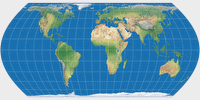
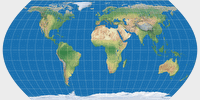




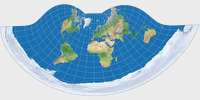
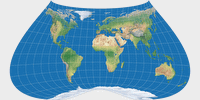
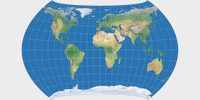
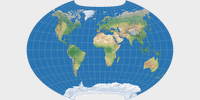
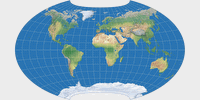
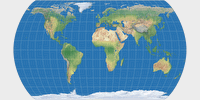
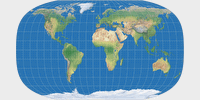
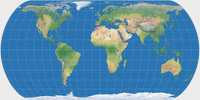
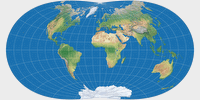
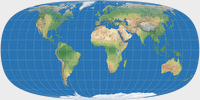
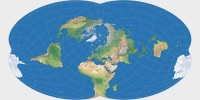
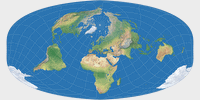
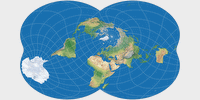
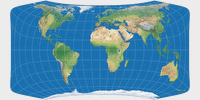
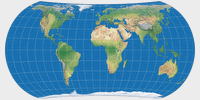
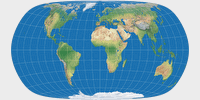
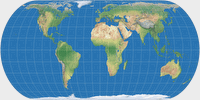

In this view, I run into problems when projections have long names…
But now I found out, that Frank Canters does not approve that kind of naming!
He mentions »the bad habit of designating a projection by the name of its author«
[2]
and states:
(…) the name of each projection should reflect the appearance of the graticule. The naming should also be brief, easy to comprehend and unequivocal. [3]
The projection that is called Canters W14 here, was labelled by Canters as low-error polyconic projection with twofold symmetry, equally spaced parallels and a correct ratio of the axes. That name surely reflects the appearance and is unequivocal. Also, it’s easy to comprehend provided that you’re a bit into map projections. For laymen however it seems awfully discombobulating, and it definitely isn’t brief.
Moreover, names like this might complicate discussion about map projections:
»Do you prefer the low-error polyconic projection with twofold symmetry and equally spaced parallels
or the
low-error polyconic projection with twofold symmetry, equally spaced parallels and a correct ratio of the axes?«
–
»I like both of them equally well but my favorite is the
low-error pseudocylindrical projection with twofold symmetry and a pole length half the length of the equator.«
– »Oh yes, that’s very nice, too, and in my opinion, much more pleasing than the
low-error pseudocylindrical projection with twofold symmetry and a correct ratio of the axes.«
See what I mean?
Granted, throwing in names like W13, W14, W16 and W17 doesn’t make it much easier, and might cause you to stop for a moment to think whether W13 refers to the low-error polyconic projection with twofold symmetry, equally spaced parallels and with or without a correct ratio of the axes.
Be that as it may… my apologies, Mr. Canters! Until I can think of something better, I’m going to stick to the names that were proposed by Dr. Böhm. For reasons of design (see above). After all, the original names are available in the info panel that is provided for each projection. And in case you’ve missed that, they are listed right here:
| Short Name | Canters’ name | |
|---|---|---|

|
Canters W01 | Optimised version of Wagner I |

|
Canters W02 | Optimised version of Wagner II |

|
Canters W06 | Optimised version of Wagner VI |

|
Canters W07 | Optimised version of Hammer-Wagner (= Wagner VII) |

|
Canters W08 | Optimised version of Wagner VIII |

|
Canters W09 | Optimised version of Aitoff-Wagner (= Wagner IX.i) |

|
Canters W10 | Low-error polyconic projection obtained through non-constrained optimisation |

|
Canters W11 | Low-error polyconic projection with straight equator and symmetry about the central meridian |

|
Canters W12 | Low-error polyconic projection with twofold symmetry |

|
Canters W13 | Low-error polyconic projection with twofold symmetry and equally spaced parallels |

|
Canters W14 | Low-error polyconic projection with twofold symmetry, equally spaced parallels and a correct ratio of the axes |

|
Canters W15 | Low-error pseudocylindrical projection with twofold symmetry |

|
Canters W16 | Low-error pseudocylindrical projection with twofold symmetry and a pole length half the length of the equator |

|
Canters W17 | Low-error pseudocylindrical projection with twofold symmetry and a correct ratio of the axes |

|
Canters W18 | |

|
Canters W19 | Low-error pointed polar pseudocylindrical projection with twofold symmetry and a correct ratio of the axes |

|
Canters W20 | Low-error simple oblique polyconic projection with pointed meta-pole and constand scale along the axes |

|
Canters W21 | Low-error simple oblique polyconic projection with pointed meta-pole and constand scale along the axes, centered at 45°N, 20°E |

|
Canters W23 | Low-error plagal aspect polyconic projection with pointed meta-pole (30°N, 140°W), geographical North Pole at meta-longitude of 30°, and constant scale along the axes. |

|
Canters W30 | Low-error equal-area transformation of Hammer-Wagner [Wagner VII] with twofold symmetry and correct ratio of the axes |

|
Canters W31 | Low-error equal-area transformation of Hammer-Wagner [Wagner VII] with twofold symmetry and constant scale along the equator |

|
Canters W32 | Low-error equal-area transformation of Hammer-Aitoff [Hammer projection] with twofold symmetry and correct ratio of the axes |

|
Canters W33 | Low-error equal-area transformation of the sinusoidal projection with twofold symmetry, equally divided, straight parallels and a correct ratio of the axes (not including Antarctica in the optimisation) |

|
Canters W34 | Low-error equal-area transformation of the sinusoidal projection with twofold symmetry, equally divided, straight parallels and a correct ratio of the axes (including Antarctica in the optimisation) |

Comments
Be the first one to write a comment!